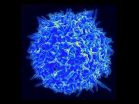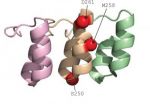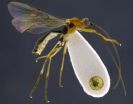(Press-News.org) What is the secret to aging more slowly and living longer? Not antioxidants, apparently.
Many people believe that free radicals, the sometimes-toxic molecules produced by our bodies as we process oxygen, are the culprit behind aging. Yet a number of studies in recent years have produced evidence that the opposite may be true.
Now, researchers at McGill University have taken this finding a step further by showing how free radicals promote longevity in an experimental model organism, the roundworm C. elegans. Surprisingly, the team discovered that free radicals – also known as oxidants – act on a molecular mechanism that, in other circumstances, tells a cell to kill itself.
Programmed cell death, or apoptosis, is a process by which damaged cells commit suicide in a variety of situations: to avoid becoming cancerous, to avoid inducing auto-immune disease, or to kill off viruses that have invaded the cell. The main molecular mechanism by which this happens is well conserved in all animals, but was first discovered in C. elegans – a discovery that resulted in a Nobel Prize.
The McGill researchers found that this same mechanism, when stimulated in the right way by free radicals, actually reinforces the cell's defenses and increases its lifespan. Their findings are reported in a study published online May 8 in the journal Cell.
"People believe that free radicals are damaging and cause aging, but the so-called 'free radical theory of aging' is incorrect," says Siegfried Hekimi, a professor in McGill's Department of Biology and senior author of the study. "We have turned this theory on its head by proving that free radical production increases during aging because free radicals actually combat – not cause – aging. In fact, in our model organism we can elevate free radical generation and thus induce a substantially longer life."
The findings have important implications. "Showing the actual molecular mechanisms by which free radicals can have a pro-longevity effect provides strong new evidence of their beneficial effects as signaling molecules", Hekimi says. "It also means that apoptosis signaling can be used to stimulate mechanisms that slow down aging".
"Since the mechanism of apoptosis has been extensively studied in people, because of its medical importance in immunity and in cancer, a lot of pharmacological tools already exist to manipulate apoptotic signaling. But that doesn't mean it will be easy."
Stimulating pro-longevity apoptotic signaling could be particularly important in neurodegenerative diseases, says Hekimi. In the brain the apoptotic signaling might be particularly tilted toward increasing the stress resistance of damaged cells rather than killing them, explains Hekimi. That's because it is harder to replace dead neurons than other kinds of cells, partly because of the complexity of the connections between neurons.
INFORMATION:
"The Intrinsic Apoptosis Pathway Mediates the Pro-Longevity Response to Mitochondrial ROS in C. elegans", Callista Yee, Wen Yang, and Siegfried Hekimi, Cell, May 8, 2014 http://dx.doi.org/10.1016/j.cell.2014.02.055
Contact:
Cynthia Lee
Relations avec les médias | Media Relations
Université McGill | McGill University
@cynthialee514
cynthia.lee@mcgill.ca
http://www.mcgill.ca/newsroom/
http://twitter.com/#!/McGillU
What doesn't kill you may make you live longer
McGill research finds unexpected link between cell suicide and longevity
2014-05-08
ELSE PRESS RELEASES FROM THIS DATE:
Population genomics study provides insights into how polar bears adapt to the Arctic
2014-05-08
May 8, 2014, Shenzhen, China – In a paper published in the May 8 issue of the journal Cell as the cover story, researches from BGI, University of California, University of Copenhagen and other institutes presented the first polar bear genome and their new findings about how polar bear successfully adapted to life in the high Arctic environment, and its demographic history throughout the history of its adaptation.
Polar bears are at the top of the food chain, and spend most of their lifetimes on the sea ice largely within the Arctic Circle. They were well known to the ...
How immune cells use steroids
2014-05-08
Hinxton, 8 May 2014 – Researchers at the European Bioinformatics Institute (EMBL-EBI) and the Wellcome Trust Sanger Institute have discovered that some immune cells turn themselves off by producing a steroid. The findings, published in Cell Reports, have implications for the study of cancers, autoimmune diseases and parasitic infections.
If you've ever used a steroid, for example cortisone cream on eczema, you'll have seen first-hand how efficient steroids are at suppressing the immune response. Normally, when your body senses that immune cells have finished their job, ...
Just keep your promises: Going above and beyond does not pay off
2014-05-08
May 8, 2014 - If you are sending Mother's Day flowers to your mom this weekend, chances are you opted for guaranteed delivery: the promise that they will arrive by a certain time. Should the flowers not arrive in time, you will likely feel betrayed by the sender for breaking their promise. But if they arrive earlier, you likely will be no happier than if they arrive on time, according to new research. The new work suggests that we place such a high premium on keeping a promise that exceeding it confers little or no additional benefit.
Whether we make them with a person ...
Universal neuromuscular training an inexpensive, effective way to reduce
2014-05-08
ROSEMENT, Ill.─As participation in high-demand sports such as basketball and soccer has increased over the past decade, so has the number of anterior cruciate ligament (ACL) injuries in teens and young adults. In a study appearing today in the Journal of Bone and Joint Surgery (JBJS) (a research summary was presented at the 2014 Annual Meeting of the American Academy of Orthopaedic Surgeons in March), researchers found that universal neuromuscular training for high school and college-age athletes—which focuses on the optimal way to bend, jump, land and pivot the knee—is ...
Collaboration between psychologists and physicians important to improving primary health care
2014-05-08
WASHINGTON - Primary care teams that include both psychologists and physicians would help address known barriers to improved primary health care, including missed diagnoses, a lack of attention to behavioral factors and limited patient access to needed care, according to health care experts writing in a special issue of American Psychologist, the flagship journal of the American Psychological Association.
"At the heart of the new primary care team is a partnership between a primary care clinician and a psychologist or other mental health professional. The team works together ...
Small mutation changes brain freeze to hot foot
2014-05-08
DURHAM, N.C. -- Ice cream lovers and hot tea drinkers with sensitive teeth could one day have a reason to celebrate a new finding from Duke University researchers. The scientists have found a very small change in a single protein that turns a cold-sensitive receptor into one that senses heat.
Understanding sensation and pain at this level could lead to more specific pain relievers that wouldn't affect the central nervous system, likely producing less severe side effects than existing medications, said Jörg Grandl, Ph.D., an assistant professor of neurobiology in Duke's ...
Statins given early decrease progression of kidney disease
2014-05-08
AURORA, Colo. (May 8, 2014) - Results from a study by University of Colorado School of Medicine researchers show that pravastatin, a medicine widely used for treatment of high cholesterol, also slows down the growth of kidney cysts in children and young adults with autosomal dominant polycystic kidney disease (ADPKD).
ADPKD is the most common potentially lethal hereditary kidney disease, affecting at least 1 in 1000 people. ADPKD is characterized by progressive kidney enlargement due to cyst growth, which results in loss of kidney function over time. At one time, ADPKD ...
Mummy-making wasps discovered in Ecuador
2014-05-08
Some Ecuadorian tribes were famous for making mummified shrunken heads from the remains of their conquered foes. Field work in the cloud forests of Ecuador by Professor Scott Shaw, University of Wyoming, Laramie, and colleagues, has resulted in the discovery of 24 new species of Aleiodes wasps that mummify caterpillars. The research by Eduardo Shimbori, Universidade Federal de São Carlos, Brazil, and Scott Shaw, was recently published in the open access journal ZooKeys.
Among the 24 new insect species described by Shimbori and Shaw, several were named after famous people ...
NASA sees system 91B lingering over southwestern India
2014-05-08
The tropical low pressure area known as System 91B has been making a slow northerly crawl while sitting inland in southwestern India, and NASA's Terra satellite captured a visible image of the struggling storm that showed half of it is over the Northern Indian Ocean.
NASA's Terra satellite passed over System 91B over southwestern India and the Moderate Resolution Imaging Spectroradiometer (MODIS) instrument captured a visible image on May 8 at 05:40 UTC/1:40 a.m. EDT. The despite having a poorly defined low-level circulation center on infrared imagery, the circulation ...
Experimental antibody shows early promise for treatment of childhood tumor
2014-05-08
Tumors shrank or disappeared and disease progression was temporarily halted in 15 children with advanced neuroblastoma enrolled in a safety study of an experimental antibody produced at St. Jude Children's Research Hospital. Four patients are still alive after more than two-and-a-half years and without additional treatment.
Findings from the Phase I study were published recently online and will appear in the May 10 edition of the Journal of Clinical Oncology. The results prompted St. Jude to expand clinical trials of the monoclonal antibody hu14.18K322A to include patients ...
LAST 30 PRESS RELEASES:
Making lighter work of calculating fluid and heat flow
Normalizing blood sugar can halve heart attack risk
Lowering blood sugar cuts heart attack risk in people with prediabetes
Study links genetic variants to risk of blinding eye disease in premature infants
Non-opioid ‘pain sponge’ therapy halts cartilage degeneration and relieves chronic pain
AI can pick up cultural values by mimicking how kids learn
China’s ecological redlines offer fast track to 30 x 30 global conservation goal
Invisible indoor threats: emerging household contaminants and their growing risks to human health
Adding antibody treatment to chemo boosts outcomes for children with rare cancer
Germline pathogenic variants among women without a history of breast cancer
Tanning beds triple melanoma risk, potentially causing broad DNA damage
Unique bond identified as key to viral infection speed
Indoor tanning makes youthful skin much older on a genetic level
Mouse model sheds new light on the causes and potential solutions to human GI problems linked to muscular dystrophy
The Journal of Nuclear Medicine ahead-of-print tip sheet: December 12, 2025
Smarter tools for peering into the microscopic world
Applications open for funding to conduct research in the Kinsey Institute archives
Global measure underestimates the severity of food insecurity
Child survivors of critical illness are missing out on timely follow up care
Risk-based vs annual breast cancer screening / the WISDOM randomized clinical trial
University of Toronto launches Electric Vehicle Innovation Ontario to accelerate advanced EV technologies and build Canada’s innovation advantage
Early relapse predicts poor outcomes in aggressive blood cancer
American College of Lifestyle Medicine applauds two CMS models aligned with lifestyle medicine practice and reimbursement
Clinical trial finds cannabis use not a barrier to quitting nicotine vaping
Supplemental nutrition assistance program policies and food insecurity
Switching immune cells to “night mode” could limit damage after a heart attack, study suggests
URI-based Global RIghts Project report spotlights continued troubling trends in worldwide inhumane treatment
Neutrophils are less aggressive at night, explaining why nighttime heart attacks cause less damage than daytime events
Menopausal hormone therapy may not pose breast cancer risk for women with BRCA mutations
Mobile health tool may improve quality of life for adolescent and young adult breast cancer survivors
[Press-News.org] What doesn't kill you may make you live longerMcGill research finds unexpected link between cell suicide and longevity




